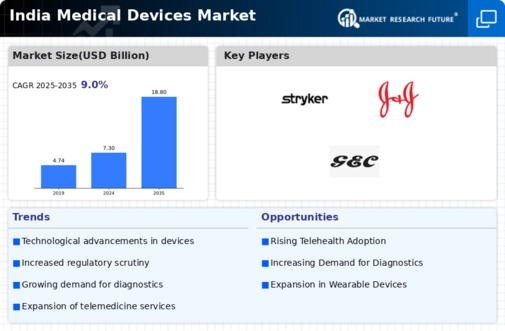Increasing Healthcare Expenditure
The medical devices market in India is experiencing growth driven by rising healthcare expenditure. The government has been increasing its budget allocation for healthcare, which is projected to reach approximately 2.5% of GDP by 2025. This increase in funding is likely to enhance the accessibility and affordability of medical devices, thereby stimulating demand. Furthermore, private sector investments are also on the rise, contributing to the expansion of healthcare infrastructure. As hospitals and clinics upgrade their facilities, the need for advanced medical devices becomes more pronounced. This trend indicates a robust growth trajectory for the medical devices market, as both public and private sectors invest in modern healthcare solutions.
Aging Population and Chronic Diseases
India's demographic shift towards an aging population is significantly impacting the medical devices market. By 2025, it is estimated that the elderly population will constitute around 10% of the total population, leading to an increased prevalence of chronic diseases such as diabetes and cardiovascular conditions. This demographic change necessitates the adoption of advanced medical devices for effective diagnosis and treatment. The demand for devices such as glucose monitors, cardiac stents, and orthopedic implants is likely to surge as healthcare providers seek to address the needs of this growing patient demographic. Consequently, the medical devices market is poised for substantial growth as it adapts to the healthcare requirements of an aging society.
Technological Integration in Healthcare
The integration of advanced technologies into healthcare practices is transforming the medical devices market in India. Innovations such as telemedicine, artificial intelligence, and the Internet of Things (IoT) are being increasingly adopted in healthcare settings. These technologies facilitate remote monitoring and improve patient outcomes, thereby driving demand for compatible medical devices. For instance, telehealth platforms require devices that can transmit patient data in real-time, leading to a surge in demand for connected medical devices. This trend suggests that the medical devices market is not only expanding in terms of volume but also evolving in terms of technological sophistication, which may enhance the overall quality of healthcare delivery.
Rising Health Awareness and Preventive Care
There is a notable increase in health awareness among the Indian population, which is positively influencing the medical devices market. As individuals become more conscious of their health, there is a growing inclination towards preventive care and early diagnosis. This trend is reflected in the rising sales of diagnostic devices, such as blood pressure monitors and home testing kits. The market for wearable health technology is also expanding, with consumers seeking devices that can monitor vital signs and fitness levels. This shift towards proactive health management is likely to drive innovation and investment in the medical devices market, as manufacturers respond to the demand for user-friendly and efficient health monitoring solutions.
Government Initiatives and Make in India Campaign
The Indian government's initiatives, particularly the Make in India campaign, are fostering a conducive environment for the medical devices market. This campaign aims to boost domestic manufacturing and reduce reliance on imports, which is crucial given that India imports a significant portion of its medical devices. By encouraging local production, the government is likely to enhance the availability of affordable medical devices, thereby increasing market penetration. Additionally, various incentives and subsidies are being offered to manufacturers, which may lead to a more competitive landscape. As a result, the medical devices market is expected to benefit from improved supply chains and reduced costs, ultimately enhancing access to essential healthcare technologies.

















Leave a Comment